|
 Gliophorus viscaurantius Gliophorus viscaurantius
SynonymsHygrocybe viscaurantia
BiostatusPresent in region - Indigenous. Endemic
Images (click to enlarge)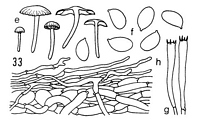
Caption: Gliophorus viscaurantius Hk. (type) e. carpophores. - f. spores. - g. basidia. - h. cuticle | 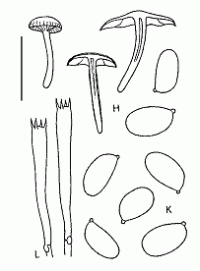
Caption: Fig. 27 Gliophorus viscaurantius Horak (H-L: PDD 27091, type):
H. basidiomes. K. spores. L. basidia. | 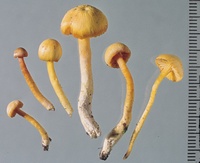
Caption: ZT71-083
Owner: E. Horak: © Creative Commons Attribution-Noncommercial 3.0 New Zealand | 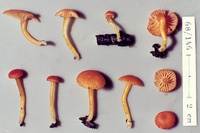
Caption: ZT68-146 , Holotype
Owner: E. Horak: © Creative Commons Attribution-Noncommercial 3.0 New Zealand | 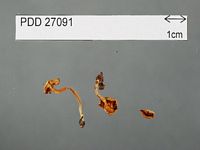
Caption: Dried type specimen
Owner: Herb PDD |
Article: Horak, E. (1990). Monograph of the New Zealand Hygrophoraceae (Agaricales). New Zealand Journal of Botany 28(3): 255-306 (http://www.rsnz.org/publish/abstracts.php).
Description: Pileus -25 mm, hemispherical becoming planoconvex or subumbonate in aged specimens;
brilliant orange at disc, red-orange towards margin, fading with age; viscid
when moist, dry becoming innate-fibrillose, hygrophanous, margin striate. -Lamellae
6-10 (1-3) distant, broadly adnate to subdecurrent; yellow, edges concolorous,
entire. - Stipe 10-25 x 1-2 mm, cylindrical, equal or gradually attenuated towards
base; concolorous with pileus at apex, paler or whitish at base; subviscid (in
wet condition) soon dry, glabrous, fistulose, single. - Context orange. – Odour
and taste not distinctive. - Chemical reactions on pileus KOH, HCl - negative.
Spores 6-7.5 x 3.5-4.5 um, ellipsoid with elongated apiculus. - Basidia 33-45
x 5-6 um, 4-spored. - cystidia absent. -Pileipellis an ixocutis of cylindrical,
hyaline, gelatinised, interwoven hyphae (3-8 um diam.), with plasmatic pigment
clamp connections present (Pl. 1, Fig. 6).
Habitat: ECOLOGY: Scattered; saprobic on rotten debris (twigs of Dacrydium) or
among litter in broadleaved-conifer forests (dominated by Nothofagus fusca,
Kunzea ericoides, Dacrydium cupressinum, Agathis australis). March-July.
Distribution: DISTRIBUTION: NZ (NA, WL).
Notes: This taxon resembles discoloured specimens of G. subheteromorphus (Sing.).
It is readily separated, however, by the glutinous, brilliant red basidiomes
and the larger spores of the latter species.
Article: Horak, E. (1973). Fungi Agaricini Novazelandiae I-V. Beihefte zur Nova Hedwigia 43: 200 p.
Description: Pileus 5-25 mm diam., hemispherical when young becoming convex, aged specimen subumbonate-plane, brilliant orange to red-orange, fading in aging, viscid when moist, innate-fibrillose in dry conditions, slightly hygrophanous, margin striated. Lamellae adnate to shortly decurrent, yellow, distant, gill edge concolorous. Stipe 10-25 x 1-3 mm, cylindric or attenuated towards the base, coloured like pileus at the apex, whitish or paler at the base, viscid, glabrous, fistulose, single, Context orange. Taste and odor not distinctive. Chemical reactions on pileus: KOH, HCl - negative.
Spores 6-7.5 x 3.5-4.5 µm, elliptic, smooth, inamyloid. Basidia 33-40 x 5 µm, 4-spored. Cystidia absent. Cuticle a cutis consisting of cylindric, hyaline slightly gelatinized, interwoven hyphae (3-8 µm diam.), clamp connections present.
Habitat: Amongst mosses or on rotten wood under Nothofagus, Dacrydium, Weinmannia, etc. New Zealand.
Notes: The presence of a viscid pellicle places this N.Z. species into Gliophorus. In the field old and degraded specimens may be confused with G. aurantiopallens Hk. whose spores however are considerably smaller.
In Europe the nearest relatives to this species represent H. insipidus (Fr.) ss. Favre (1960) whilst in Venezuela H. hondurensis Dennis appears to be akin t o G. viscaurantius.
|